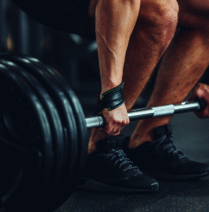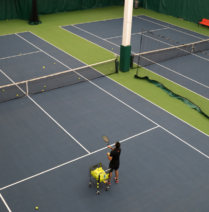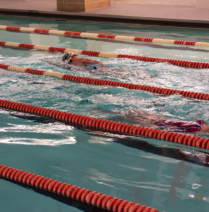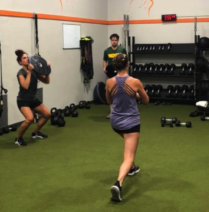
With fitness centers temporarily closed in the Chicago area, many are resorting to at-home workouts, either on their own or through virtual classes. Bodyweight exercises are convenient as they don’t require any gym equipment. However, if you’re not accustomed to doing bodyweight exercises, you might be prone to mistakes (especially if you can’t check your exercise form). We’ve highlighted 10 exercises you might be doing wrong and ways you can fix them.
10 Exercise Form Mistakes
1. Plank
The most common mistakes people make when planking are sagging their hips too low or raising them too high. Sagging hips cause your back to collapse. If your hips are too high, the exercise isn’t working your core like it should. So tighten your core and maintain alignment in you shoulders, hips, and heels.
2. Sit-Ups
When performing sit-ups, most people put their hands behind their head. Because of this, they have a tendency to pull on their neck. The objective of sit-ups is to strengthen your core, so the focus should be on your abdominals, obliques, and lower back. You want to tighten your abdominal muscles to pull you upward. You can also cross your arms on your chest to prevent pulling on your neck.
Another mistake is lifting your chin up too high. Look straight ahead and let your core do the work. Lastly, keep your feet flat on the floor.
3. Glute Bridge
The glute bridge is a great way to strengthen your glutes, hamstrings, and lower back, resulting in better posture – especially helpful if you sit a lot during the day. To perform a glute bridge, lie down with bent knees and keep your feet flat on the floor with arms at your sides. Slowly lift your hips off the floor so your knees, hips, and shoulders are aligned. Squeeze your glutes and draw in your abs.
Avoid flaring your chest or lifting your hips too high, thus arching your back. Don’t push off your toes. Instead, drive through your heel and keep your feet flat on the floor.
4. Squats
Squats are one of the best exercises for strengthening your legs. They work your glutes, hamstrings, quads, and calves, and even your core as well.
One of the more common mistakes with squats is that people start by bending their knees. What you should do instead is push your hips back and keep a neutral spine (don’t allow it to arch). Think of sitting back onto a chair. As you push your butt back, shift your weight to your heels to maintain balance.
As far as feet positioning goes, they should be about shoulder-width apart and pointing forwards. Avoid letting your knees cave inward as you move down into the squat position. They should be in line with your toes as you move down into your squat.
5. Push-Ups
Push-ups are an excellent way to strengthen the upper body using nothing but bodyweight. You might still be surprised how many people have poor exercise form when doing push-ups.
A common mistake with push-ups has to do with elbow positioning, where they flare outward to form a T-shape. Actually, your elbows should form a 45-degree angle from your body. To help correct this, position your hands about shoulder-width apart or just slightly wider. Positioning your hands too wide will cause your elbows to flare outward.
Another thing you want to keep in mind is to keep your whole body aligned – from shoulder to heel (like a plank). Your whole body should move up and down together. Sometimes as people get more fatigued, their upper body comes up higher and this causes the back to collapse.
Lastly, make sure you finish each rep completely. What we mean is that your chest should touch the ground and you use your full range of motion. You should pace the amount of reps you do in each set if you get fatigued.
6. Triceps Dips
Triceps dips are perfect for at-home workouts because they can be done on any sturdy furniture like a bench, chair, or couch. The objective is to isolate your triceps and shoulders so you want to avoid flaring your elbows outwards. Keep them in line with your shoulders and squeeze your shoulder blades together. Don’t crunch your chest as this will cause your back to arch too much and force your shoulders too far forward. Leave your chest open and your shoulders down and back.
7. Forward Lunges
The forward lunge is a simple way to strengthen the leg muscles responsible for forward movement. When you step forward into your lunge, your front knee should form a 90-degree angle. What you want to avoid is allowing your knee to go too far forward. It should line up right over your toes. Another mistake is allowing the upper body to lean too far forward. Keep that upper body vertical throughout the entire exercise. Hold your chest up and look straight ahead.
8. Side Lunges
Just like with the forward lunge, your bent knee should be in line with your toes. Avoid overextending as this will put unwanted strain on the knee. Foot positioning is also important. The toes of your bent leg shouldn’t point outward. They should always point forward and stay parallel with your plant foot. Keep both feet flat on the floor. Sometimes the plant foot has a tendency to lift off the floor and your ankle can buckle, thus risking injury.
9. Donkey Kicks
Want to warm up your glutes and hip flexors? Start with donkey kicks! We want to isolate the glutes with this exercise so the lower back should be flat and hips should be in a neutral position. With knees still bent, kick back one leg at a time, keeping your hips stable. Don’t kick too far, as this will cause your back to overarch. As you extend your leg back, keep your foot parallel to the planted leg and avoid turning it inward or outward.
10. Mountain Climbers
One of the most common mistakes with mountain climbers has to do with the starting position. The starting position is the same as a push-up with your arms extended, which means that some people tend to stick their butt too high in the air. Keep your whole body aligned in a straight line from shoulders to heels.
After you’re set up properly, you would bend one knee and drive it towards your chest, and then switch legs. It’s a relatively quick movement so people have a tendency to “bounce” up and down. To prevent bouncing, don’t allow your toes to touch the ground as you drive your knee to your chest. Also, keep your hips stable and don’t sway to either side.
Safety First
Safety is always a top priority – hence the importance of proper exercise form. We want the movement to be effective at working our muscles, but we also want to avoid any risk of injuring ourselves. A few additional tips we’d like to include are to never hold your breath and maintain control of your movements. Sometimes that means slowing things down and always be mindful of what your body is doing.
Sign up for weekly exercise tips and download our visual exercise form guide to help you with your at-home workouts!
Tags: at-home workouts, chicago fitness, exercise form, exercise tips




